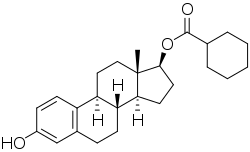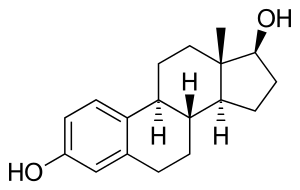Estradiol hexahydrobenzoate
Estradiol hexahydrobenzoate (EHHB), sold under a number of brand names including Benzo-Ginoestril A.P., BenzoGynoestryl Retard, Ginestryl-15-Depot, Menodin, and Tardoginestryl, is an estrogen medication which was previously used for indications such as menopausal hormone therapy and gynecological disorders.[1][2][3][4][5] EHHB is given by injection into muscle at regular intervals, for instance once every few weeks.[3][5][6][7]
 | |
| Clinical data | |
|---|---|
| Trade names | Benzo-Ginoestril A.P., BenzoGynoestryl Retard, Ginestryl-15-Depot, Menodin, Tardoginestryl |
| Other names | EHHB; Estradiol cyclohexanecarboxylate; ECHC; Oestradiol hexahydrobenzoate; Estradiol 17β-hexahydrobenzoate; Estradiol 17β-cyclohexanecarboxylate |
| Routes of administration | Intramuscular injection |
| Drug class | Estrogen; Estrogen ester |
| Identifiers | |
IUPAC name
| |
| CAS Number | |
| PubChem CID | |
| ChemSpider | |
| UNII | |
| ECHA InfoCard | 100.035.623 |
| Chemical and physical data | |
| Formula | C25H34O3 |
| Molar mass | 382.544 g·mol−1 |
| 3D model (JSmol) | |
SMILES
| |
InChI
| |
Side effects of EHHB include breast tenderness, breast enlargement, nausea, headache, and fluid retention.[8] EHHB is a synthetic estrogen and hence is an agonist of the estrogen receptor, the biological target of estrogens like estradiol.[9][10] It is an estrogen ester and a prodrug of estradiol in the body.[10][9] Because of this, it is considered to be a natural and bioidentical form of estrogen.[10]
EHHB was first described in 1956,[11][12] and was introduced for medical use by 1957.[6] It was used in France.[6] The medication should not be confused with estradiol benzoate (EB), which has been marketed under similar brand names including Benzo-Ginestryl, Benzo-Ginoestril, and Benzo-Gynoestryl.[3][6][13]
Medical uses
EHHB was marketed in France in a 5 mg/mL oil solution in ampoules for intramuscular injection at regular intervals, for instance once every few weeks.[3][5][6][7] Use of EHHB for feminizing hormone therapy in transgender women has been reported.[14] A combination of 3 mg EHHB, 75 mg hydroxyprogesterone caproate, and 100 mg testosterone hexahydrobenzoate in 2 mL oil solution provided in ampoules has been marketed under the brand name Trinestril AP in Brazil.[15][16][17] Its indications include menopausal hormone therapy and the treatment of functional uterine bleeding.[15] The combination is administered typically once per month by intramuscular injection.[15]
Pharmacology

Pharmacodynamics
EHHB is an estradiol ester, or a prodrug of estradiol.[10][9][18] As such, it is an estrogen, or an agonist of the estrogen receptors.[10][9] EHHB is of about 40% higher molecular weight than estradiol due to the presence of its C17β cyclohexanecarboxylate ester.[1] Because EHHB is a prodrug of estradiol, it is considered to be a natural and bioidentical form of estrogen.[10]
Pharmacokinetics
A combination of EHHB and norgestrel as a combined injectable contraceptive reportedly has a duration of action of about 3 weeks.[19]
Chemistry
EHHB, also known as estradiol cyclohexanecarboxylate (ECHC) as well as estradiol 17β-hexahydrobenzoate or estradiol 17β-cyclohexanecarboxylate, is a synthetic estrane steroid and an estrogen ester.[1][2][3][4] It is specifically the C17β cyclohexanecarboxylate (hexahydrobenzoate) ester of estradiol.[1][2]
History
EHHB was first described and characterized in 1956.[11][12] It was developed in France.[11][12] The medication was introduced for medical use in France by 1957.[6] A publicized case report of a rapidly growing breast cancer tumor in a 53-year-old woman 10 days after initiation of therapy with 5 mg/month EHHB by intramuscular injection for hot flashes was published in 1962.[20][21][22] The woman died due to breast cancer 10 months after the diagnosis.[20][22]
Society and culture
Generic names
Estradiol hexahydrobenzoate is the generic name of the drug and its INN), while oestradiol hexahydrobenzoate is its BANM.[1][2][3][4] The medication is also known as estradiol cyclohexanecarboxylate (ECHC).[1][2][3][4]
Brand names
EHHB has been marketed under the brand names Benzo-Ginoestril A.P., BenzoGynoestryl Retard, Ginestryl-15-Depot, Menodin, and Tardoginestryl.[1][2][3][4][5]
Availability
EHHB was previously marketed in France.[6]
Research
A combination of 5 mg EHHB in peanut oil solution and 25 mg norgestrel in aqueous suspension as a once-monthly combined injectable contraceptive was studied, but this formulation was ultimately never marketed.[23][24][25][26][27][19]
References
- J. Elks (14 November 2014). The Dictionary of Drugs: Chemical Data: Chemical Data, Structures and Bibliographies. Springer. p. 898. ISBN 978-1-4757-2085-3.
- I.K. Morton; Judith M. Hall (6 December 2012). Concise Dictionary of Pharmacological Agents: Properties and Synonyms. Springer Science & Business Media. pp. 114, 206. ISBN 978-94-011-4439-1.
- Muller (19 June 1998). European Drug Index: European Drug Registrations, Fourth Edition. CRC Press. pp. 150–. ISBN 978-3-7692-2114-5.
- William Martindale; Royal Pharmaceutical Society of Great Britain. Dept. of Pharmaceutical Sciences (1993). The Extra Pharmacopoeia. Pharmaceutical Press. p. 1191. ISBN 978-0-85369-300-0.
Oestradiol Hexahydrobenzoate (13039-d) Oestradiol Hexahydrobenzoate (BANM). Estradiol Hexzihydrobcnzoate (rlNNM). Estra-1,3,5(10)-triene-3,17β-diol l7-cyclohexanecarboxylate. C25H34O3 = 382.5. CAS — 15140-27-9.
- IARC Working Group on the Evaluation of Carcinogenic Risks to Humans; World Health Organization; International Agency for Research on Cancer (2007). Combined Estrogen-progestogen Contraceptives and Combined Estrogen-progestogen Menopausal Therapy. World Health Organization. pp. 388–. ISBN 978-92-832-1291-1.
- France (August 1957). Journal officiel de la République française.
BENZOGYNOESTRYL 1, ampoules injectables de 1 cm* A 1 mg (2 ou 10). BENZOGYNOESTRYL 5, ampoules injectables de 1 cm3 à 5 mg (1 ou 10). BENZOGYNOESTRYL-RETARD 5 mg, ampoules injectables Ci/1 cm3).
- France (1976). Journal officiel de la République française. Édition des lois et décrets. p. 1843.
Spécialité dénommée BENZO-GYNOESTRYL RETARD, soluté injectable : Laboratoires Roussel, 75323 Paris CEDEX 07. — A. M. M. n" 301063.1 (1 ampoule de 1 ml) [...]
- Amit K. Ghosh (23 September 2010). Mayo Clinic Internal Medicine Board Review. OUP USA. pp. 222–. ISBN 978-0-19-975569-1.
- Kuhl H (2005). "Pharmacology of estrogens and progestogens: influence of different routes of administration" (PDF). Climacteric. 8 Suppl 1: 3–63. doi:10.1080/13697130500148875. PMID 16112947.
- Michael Oettel; Ekkehard Schillinger (6 December 2012). Estrogens and Antiestrogens II: Pharmacology and Clinical Application of Estrogens and Antiestrogen. Springer Science & Business Media. p. 261. ISBN 978-3-642-60107-1.
Natural estrogens considered here include: [...] Esters of 17β-estradiol, such as estradiol valerate, estradiol benzoate and estradiol cypionate. Esterification aims at either better absorption after oral administration or a sustained release from the depot after intramuscular administration. During absorption, the esters are cleaved by endogenous esterases and the pharmacologically active 17β-estradiol is released; therefore, the esters are considered as natural estrogens.
- Feyel-Cabanes T (1956). "A propos d'un nouvel oestrogène retard le 17-hexahydrobenzoate d'oestradiol" [A new estrogen with retarded action, estradiol-17-hexahydrobenzoate]. Comptes Rendus des Seances de la Societe de Biologie et de ses Filiales (in French). 150 (11): 1881–1883. ISSN 0037-9026. PMID 13427258.
- Guiard E (June 1956). "Action physiologique et clinique de deux hormones-retard; 1. l'hexahydrobenzoate de testosterone, 2. l'hexahydrobenzoate d'oestradiol" [Physiologic and clinical action of long-acting hormones; 1. testosterone hexahydrobenzoate, 2. estradiol hexahydrobenzoate]. La Presse Médicale (in French). 64 (52): 1223–1224. ISSN 0032-7867. PMID 13350115.
- Richard J. Lewis (13 June 2008). Hazardous Chemicals Desk Reference. John Wiley & Sons. pp. 593–. ISBN 978-0-470-18024-2.
- Don Kulick (12 January 2009). Travesti: Sex, Gender, and Culture among Brazilian Transgendered Prostitutes. University of Chicago Press. pp. 64, 244. ISBN 978-0-226-46101-4.
- https://web.archive.org/save/http://xock.org/b/bulas/medicamentos/trinestril-a-p/
- Sweetman, Sean C., ed. (2009). "Sex hormones and their modulators". Martindale: The Complete Drug Reference (36th ed.). London: Pharmaceutical Press. pp. 2100, 2124–2125. ISBN 978-0-85369-840-1.
- http://www.drcarlos.med.br/climamed.html
- The Rules Governing Medicinal Products in the European Union. Office for Official Publications of the European Communities. 1996. ISBN 978-92-827-6427-5.
Oestradiol benzoate, oestradiol valerate and oestradiol hexahydrobenzoate are synthetic esters of the naturally occurring oestrogen oestradiol. After administration the esters are absorbed and subsequently hydrolysed to the active compound oestradiol. Oestradiol is the most active natural oestrogen, which can act at many different sites in both female and male animals.
- D F Hawkins; M G Elder (22 October 2013). Human Fertility Control: Theory and Practice. Elsevier Science. pp. 110–. ISBN 978-1-4831-6361-1.
- Juret P, Autissier P (September 1962). "Cancer du sein en poussée évolutive découvert après plusieurs injections d'hexahydrobenzoate d'oestradiol" [Breast cancer of subacute development discovered after injections of estradiol hexahydrobenzoate]. La Presse Médicale (in French). 70 (30): 1813. ISSN 0032-7867. PMID 13958106.
- Evaluation of the Potential Carcinogenic Action of a Drug: Proceedings of the Symposium in Lausanne, January 1964. Excerpta Medica Foundation. 1964. p. 96.
In 1962, Juret and Antissier described a woman aged 53 who, 10 days after an injection of 5 mg. oestradiol hexahydrobenzoate, showed a rapidly growing mammary carcinoma.
- Carcinogenesis Abstracts. National Cancer Institute. 1973. p. 900.
A rapidly growing lump developed in a 53yr-old woman 1 wk after she had been given estradiol hexahydrobenzoate (5 mg/month) for hot flashes. The patient died of breast cancer 10 months later.
- de Souza, J. C.; Coutinho, Elsimar M. (1972). "Control of fertility by monthly injections of a mixture of norgestrel and a long-acting estrogen". Contraception. 5 (5): 395–399. doi:10.1016/0010-7824(72)90031-5. ISSN 0010-7824. PMID 4650657.
- Toppozada MK (April 1994). "Existing once-a-month combined injectable contraceptives". Contraception. 49 (4): 293–301. doi:10.1016/0010-7824(94)90029-9. PMID 8013216.
- Newton JR, D'arcangues C, Hall PE (1994). "A review of "once-a-month" combined injectable contraceptives". J Obstet Gynaecol (Lahore). 4 Suppl 1: S1–34. doi:10.3109/01443619409027641. PMID 12290848.
- Goldsmith, A., & Toppozada, M. (1983). Long-acting contraception. pp. 94-95 https://www.popline.org/node/423289 Archived 2019-03-24 at the Wayback Machine
- Toppozada M (June 1977). "The clinical use of monthly injectable contraceptive preparations". Obstet Gynecol Surv. 32 (6): 335–47. doi:10.1097/00006254-197706000-00001. PMID 865726.